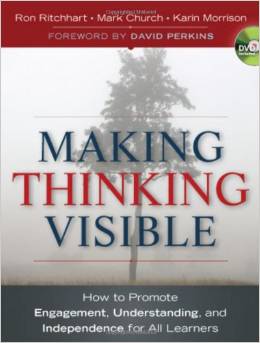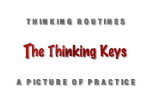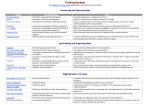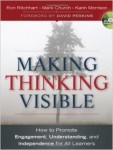“Technology Can Make Thinking Visible.”
Visible Thinking from Project Zero at Harvard University includes methods for making students’ thinking visible to themselves, to their peers, and to the teacher. Visible Thinking makes extensive use of learning routines that are thinking rich. Thinking Routines are mini-strategies that extend and deepen students’ thinking and become part of the fabric of everyday classroom life. These routines encourage the development of a culture of thinking and can be used across all grade levels and content areas.
Teachers can develop opportunities for students to make their thinking visible with technology. With freely available technologies students can engage in Thinking Routines to provide evidence of their thinking and demonstrate their understanding of course content in multiple ways (images, audio, video, presentations, artwork, and more). When thinking is visible in classrooms, students are in a position to be more metacognitive, to think about their thinking. When thinking is visible, it becomes clear that school is not about memorizing content but exploring ideas. Teachers benefit when they can see students’ thinking because misconceptions, prior knowledge, reasoning ability, and degrees of understanding are more likely to be uncovered. Teachers can then address these challenges and extend students’ thinking by starting from where they are.
Lessons and activities that integrate the Visible Thinking Routines with technology often simultaneously incorporate 21st century skills. Thus, making thinking visible with technology (MTVT) provides opportunities to weave together many of the tenants and best practices for which educational innovations and reform measures call. MTVT activities can incorporate higher-order thinking skills and deep reflection, increased student engagement, technology integration, creativity, 21st century skills, digital citizenship, evidence of student performance and understanding along with the related curriculum and content standards. Given that the average American year-long K-12 class meets for approximately 180 total hours, teachers often voice concern about about the lack of time to incorporate all of these various standards, skills, topics, and techniques in their classes. Rather than trying to “cover” each of these in isolation, MTVT provides opportunities to embed students in rich learning opportunities where these tenants are meshed together. It’s an opportunity to make learning whole.

The following are great resources for making thinking visible in your classroom:
This website provides teachers with quick-reference to the Visible Thinking routines.
This Matrix of Thinking Routines organized by engagement level is handy during lesson planning.
This infographic spotlights some of the hottest online and mobile tools for empowering students to make their thinking visible.
Browse these bookmarks for resources about the following topic: HOTS, Assessment, Technology Integration, Lesson Plans, Resources, Games, and Digital.
This blog includes access the following tag(s) for blog posts and resources related to this topic: Making Thinking Visible, Teaching for Understanding, Project Zero, Curriculum Integration, Teaching, Technology Integration, Lesson Plans/Activities/Ideas.
Visit Ron Ritchhart’s website for expert ideas for using thinking routines and effective questioning to promote a culture of thinking.





